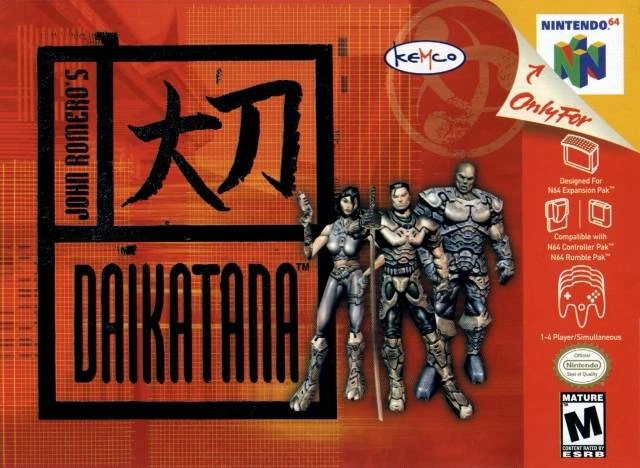Developer: Kemco (Port) Ion Storm (PC Original) Publisher: Kemco
Released: July 31, 2000 Rated: M 3/10
This is one of only a handful of profiles in this book where I feel I really have to collect myself and hold back some of my thoughts, because they all chip away at the same general failure of John Romero’s Daikatana, or at least, the Kemco-developed and published port of John Romero’s Daikatana for the N64 — this game is an utter failure of game design at just about every opportunity. It is, quite possibly, the worst functional title in the N64’s catalog, which is why, in spite of my disdain, I can’t bear to rate it a lowly one or two out of 10, just in case people interpret some of the design choices as something shy of total failure.

But first, some housekeeping on this one — John Romero’s Daikatana is an okay game. On the PC, in its full form. I had little understanding of just how greatly the two versions of the game might differ, and while its reputation preceded it, I had come to understand Daikatana not as completely irredeemable garbage, but an early example of the tumultuous development, unfulfilled promises, and off-the-rails locomotive of hype that has become all too common in the modern gaming landscape. It’s fine, but fine doesn’t live up to expectations, something I was even able to confirm via a good friend and classic FPS aficionado who started Daikatana for the first time right as I was playing it on 64.

The N64 version of Daikatana is not only inferior across the board to its proper counterpart on PC — lacking any refinement in control, graphical fidelity, voice-acted cutscenes, and what seems to be about half a game’s worth of actual content, including level count. Daikatana might just be inferior to every single other FPS on the N64 in every way. Some are the products of pure laziness, like how across its four episodes, each containing multiple chapters, gameplay only has one barebones music track for that entire episode. Or how its sparsely-populated levels resemble something like an alpha build, with one or two enemies at a time staggering in like drunks to get blasted away in one hit lacking any semblance of AI.

Other problems are simply inherent to the absolute mess John Romero thought would make a cool video game in the late-‘90s, as time travel, cyberpunk, samurai swords, and, of course, giant freakin’ guns all cross over into one massive pile of adolescent comic book vomit. I would even go so far as to say that I like some of the designs of the weapons, except that, in one of many small but infuriating design choices, some weapons actually have knockback. You can just push yourself backwards off a ledge or into a hazard by firing your rocket launcher. And your in-game weapon-select wheel doesn’t pause the game. And it takes up the entire screen so you can’t see while you’re changing. And about a hundred other things that should be easy decisions to get right and just aren’t. Worse than Armorines. Worse than South Park. And yet, somehow, not the worst crime Kemco could commit on this console. Astonishing.
Continuing Legacy
John Romero’s about to make you his bitch. Suck it down. The crude (even for the late ‘90s) magazine ad and so many other telltale signs from Daikatana’s original development cycle should have been a warning to future companies, but really it just became the progenitor of gaming media and the AAA development pattern as we know it today. Cyberpunk 2077, Fallout 76, Spore, the list goes on.
Additional Information
Saves: Controller Pak
Compatible With: Rumble Pak, Expansion Pak
Players: 1-4
Print Guides: Prima (Guide made for original PC version, has limited usage for N64 port)
Aggregate Critical Reception (GameRankings): 42.34%, based on 5 reviews
Other Releases: JP, April 7, 2000
EU, May 26, 2000
My Streams
Commercials and Print Ads






